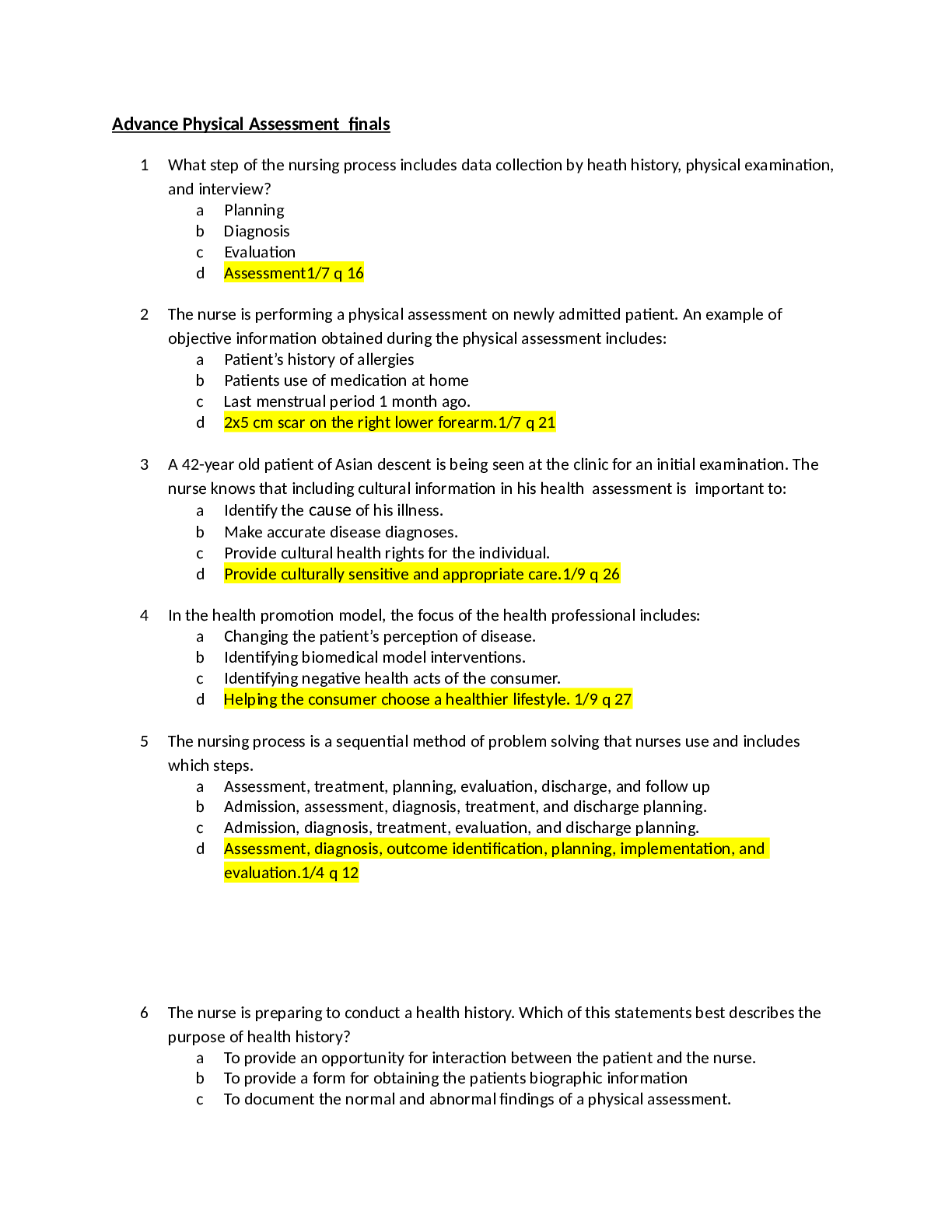What step of the nursing process includes data collection by heath history, physical examination,
and interview?
a Planning
b Diagnosis
c Evaluation
d Assessment1/7 q 16
2 The nurse is performing a physical assessment on newly admitted patient. An example of
objective information obtained during the physical assessment includes:
a Patient’s history of allergies
b Patients use of medication at home
c Last menstrual period 1 month ago.
d 2x5 cm scar on the right lower forearm.1/7 q 21
3 A 42-year old patient of Asian descent is being seen at the clinic for an initial examination. The
nurse knows that including cultural information in his health assessment is important to:
a Identify the cause of his illness.
b Make accurate disease diagnoses.
c Provide cultural health rights for the individual.
d Provide culturally sensitive and appropriate care.1/9 q 26
4 In the health promotion model, the focus of the health professional includes:
a Changing the patient’s perception of disease.
b Identifying biomedical model interventions.
c Identifying negative health acts of the consumer.
d Helping the consumer choose a healthier lifestyle. 1/9 q 27
5 The nursing process is a sequential method of problem solving that nurses use and includes
which steps.
a Assessment, treatment, planning, evaluation, discharge, and follow up
b Admission, assessment, diagnosis, treatment, and discharge planning.
c Admission, diagnosis, treatment, evaluation, and discharge planning.
d Assessment, diagnosis, outcome identification, planning, implementation, and
evaluation.1/4 q 12
6 The nurse is preparing to conduct a health history. Which of this statements best describes the
purpose of health history?
a To provide an opportunity for interaction between the patient and the nurse.
b To provide a form for obtaining the patients biographic information
c To document the normal and abnormal findings of a physical assessment.
d To provide a database of subjective information about the patients past and current
health.4/1 q 1
7 A patient tell the nurse that he is allergic to penicillin. What would be the nurse’s best response
to this information?
a “Are you allergic to any other drugs?”
b “How often have you received penicillin?”
c “I’ll write your allergy on your chart so you won’t receive any penicillin.”
d “Describe what happen to you when you take penicillin”4/3 q 8
8 The nurse is asking a patient for his reason for seeking care and ask a about the signs and
symptoms he is experiencing. Which of this is an example of a symptoms?
a Chest pain 4/10 q 27
b Clammy skin
c Serum potassium level at 4.2 mEq/L
d Body temperature of 100 deg F
9 When performing a physical assessment, the first technique the nurse will always use is:
a Palpation
b Inspection 8/1 q 1
c Percussion
d Auscultation
10 The nurse is assessing a patient’s skin during an office visit. What part of the hand and technique
should be used to best assess the patients skin temperature?
a Fingertips; they are more sensitive to small changes in temperature.
b Dorsal surface of the hand; the skin is thinner on this surface than on the palm 8/2 q 3.
c Ulnar portion of the hand; increased blood supply in this area enhances temperature
sensitivity.
d Palmar surface of the hand; this surface is the most sensitive to temperature variations
because of it’s increased nerve supply in this area.
11 Which of this techniques uses the sense of touch to assess texture, temperature, moisture, and
swelling when the nurse is assessing a patient?
a Palpation 8/2 q 4
b Auscultation
c Inspection
d Percussion
12 The nurse is preparing to assess a patients abdomen by palpitation. How should the nurse
proceed?
a Palpation of reportedly “tender” areas are avoided because palpation in these areas may
cause pain.
b Palpating a tender area is quickly performed to avoid any discomfort that the patient
may experience.
c The assessment begins with deep palpation, while encouraging the patient to relax and
to take deep breaths.
d The assessment begins with light palpation to detect surface characteristics and to
accustom the patient to being touched.8/2 q 5
13 The nurse would use bimanual palpation technique in which situation?
a Palpating the thorax of an infant.
b Palpating the kidneys and uterus 8/2 q 6
c Assessing pulsations and vibrations
d Assessing the presence of tenderness and pain.
Read More
.png)

